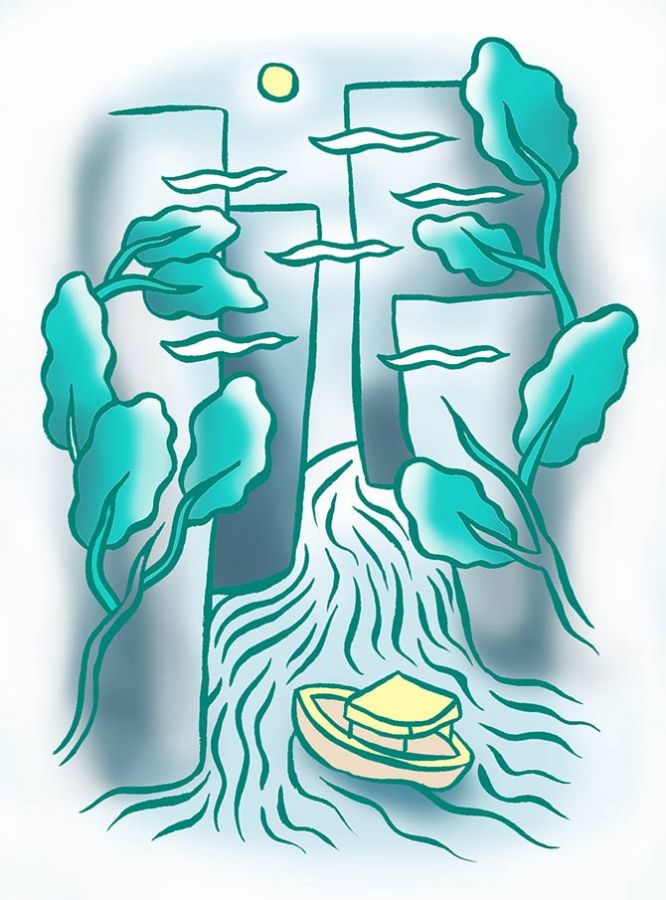Of India's sacred rivers, she is the holiest.
It is believed that even the Ganga comes in the form of a cow for a purifying bath in the Narmada, says Geetanjali Krishna.
Illustration: Uttam Ghosh/Rediff.com

I've always thought of rivers as creatures with distinct personalities.
Flowing voluptuously through the high altitude desert lands of Lahaul and Spiti, the Chandrabhaga, or Chenab, is a powerful jade goddess, untamed and wild.
The Ganges, on the other hand, when it settles into a serene middle-aged spread around Varanasi, is the eternal mother in whose lap all life eventually comes to rest.
The river that I find most captivating is the Narmada, whose very name means 'the giver of pleasure.'
She's the diva that few can ignore; fewer remain untouched by her beauty.
Of India's sacred rivers, she is the holiest. It is believed that even the Ganga comes in the form of a cow for a purifying bath in the Narmada.
As we travel in Madhya Pradesh, the state where she originates, I ruminate that there seem to be as many myths surrounding the Narmada as there are about the Ganges.
Beyond Bhedaghat, 20 km from Jabalpur in Madhya Pradesh, I can see why the Narmada has come to inspire poets and bards over the ages.
Beauteous and serene, with waters so greenly mysterious, it is easy to imagine that all the stories about her are true.
Bhedaghat itself is rather unprepossessing at first glance. Like many other riverbanks in India, it's a chaotic mix of temples, priests, shops and monkeys -- all making a living from the pilgrims who throng here in vast numbers.
The story goes that the Narmada was formed from the rivulets of sweat that flowed from Shiva when he was deep in meditation at Amarkantak. This has led to the belief that a ritual dip in the river cleanses one of all sins.
Another myth -- that every stone in the river is naturally shaped like a Shiva lingam -- has prompted locals to sell phallus-shaped stones as bizarre souvenirs. As I make my way to the steps where our boat awaits, I hope there are some stones left in the river for us to admire.
At water's edge, a motorboat with a decrepit guide awaits us.
We set sail, leaving the chaos of Bhedaghat behind, and the guide starts to speak.
It is the first time that I've heard anyone carry out entire conversations in verse; clearly the guide has literary pretensions.
We become so engrossed in his poetic commentary that we don't even notice the cliffs closing in on us. The water darkens to a deep shade of emerald and we find ourselves at the bottom of a gorge.
On either side are the famed marble cliffs of Bhedaghat, not the shiny bright of the marble one sees on Delhi's 'builder floors', but golden with age.
They are craggy and weathered with layers of substrata bearing visible evidence to their age and nature of origin.
A deep sense of peace, punctuated only by the occasion splash of the oar, descends upon us.
In hushed tones, our literary guide points out spots where Bollywood movies have been shot (and there have been many of them).
Streaked with green and brown volcanic rocks and shimmering in the sun, the marble cliffs stretch on and on as we sail through the gorge.
Soon, the gorge narrows so dramatically at the 'Bandar Kud' point that they say monkeys are able to easily jump across.
Ahead, we spot two boys teeter on top of a cliff, shouting to us in their high-pitched voices. "They want you to throw coins in the river," says the boatman, "so that they can dive from there to get them."
We are appalled by the idea, but some tourists in another boat throw in a handful, and they launch themselves from the 50-odd-foot high cliff fearlessly, breaking the water with barely a splash.
Later, as I meander around Dhuandhar Falls, where the river drops several feet enveloped in a fine smoky mist, I wonder at the human propensity to plunder nature for short-term development goals.
The government's proposal to build two dams on the Narmada would not only obliterate much of her natural features, but it would also displace tens of thousands of people that live and depend on it.
Ma Rewa, a song by India's best known indie band, Indian Ocean, plays in my head as I think of the people who live by her banks and regard the river as their mother.
Their protest has been powerful and peaceful, even though it has been met with extensive State-sponsored repression.
If it weren't for this movement, known to the world as the Narmada Bachao Andolan, perhaps the view I'm admiring right now would cease to exist.
So I come away from Narmada, carrying the impression of a diva desperately clutching on to her beauty; a beauty that is made more poignant by the threat of its destruction.














